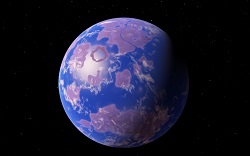Trending Science: A planet has been discovered orbiting the closest star to the Solar System – and may support life
The planet, named Proxima b is at least 1.3 times the size of Earth and is most likely rocky, according to research published in the journal ‘Nature’. The planet is also very close to Proxima Centauri, located around 4.3 million miles from the star – or just 5 % of the distance of the Earth from the Sun. Consequently, Proxima b has a much shorter orbit than our own, a mere 11.2 days. This is about an eighth of the length of Mercury’s orbit. This gives Proxima b an ideal location – Proxima Centauri is a cool red dwarf star, much smaller than our Sun. As a result, Proxima Centauri’s ‘habitable zone’ is much closer to the star than it is to our Sun. This means that Proxima b may have liquid water, the key ingredient for life here on Earth, which theoretically could allow for the presence of life on Proxima b. The discovery is all the more exciting as this means that the search for extraterrestrial life just got a lot closer to home than we had previously dared to imagine. So how did astronomers make this phenomenal discovery? They did it by continuously observing Proxima Centauri during the first half of 2016, part of a programme called the Pale Red Dot Campaign. They didn’t see the planet directly but worked out that the planet existed based on how Proxima Centauri moves. As Proxima b orbits around the star, the small world’s gravity pulls on Proxima Centauri, causing the star to wobble on its axis. It was through the study of these wobbles that allowed the scientists to conclude that there was indeed a planet around Proxima Centauri. Though Proxima b orbits within its sun’s habitable zone, it probably has a very different climate to our own. There is speculation that Proxima b would not have seasons and because it’s so close to Proxima Centauri, it is blasted by much more radiation than the Earth. If liquid water does exist on the world, it is possible that it is located only in regions directly facing its sun or along some form of tropical belt. The next step is to get a better look at the exoplanet, specifically its atmospheric conditions. If there are certain gases present, such as oxygen and methane, this could indicate the existence of liquid water or even, most excitedly, biological life. If Proxima b passes between its star and the Earth (a so-called ‘transiting exoplanet’) this would provide the best opportunity for studying the planet more closely. Astronomers may then be able to see how Proxima b dims its sun when passing in front of the star, which could give them clues on the planet’s radius and density. By seeing how Proxima Centauri’s light filters through the atmosphere, they could also be able to study the gasses in the planet’s atmosphere. However, it’s very unlikely that Proxima b is a transiting planet - only a 1.5 % chance - and matters are complicated by the fact that Proxima Centauri is a flare star, which means that its brightness changes in unpredictable ways. Conventionally imaging the planet is the next best bet and this will not be easy, as Proxima Centauri’s light easily drowns out the planet, and astronomers are currently not equipped with the telescopes necessary to pierce this light - such technology is likely to still be decades away. However, this discovery is indeed an important milestone of the quest to find life beyond our own small planet, and it is likely that other astronomers will be motivated to study the planet in greater detail. Although hundreds of other exoplanets have been discovered which are, on paper, much better candidates for sustaining biological life, Proxima b’s discovery has stoked excitement based on just how phenomenally close it is to Earth – a mere 4.25 light years.
Countries
Germany



